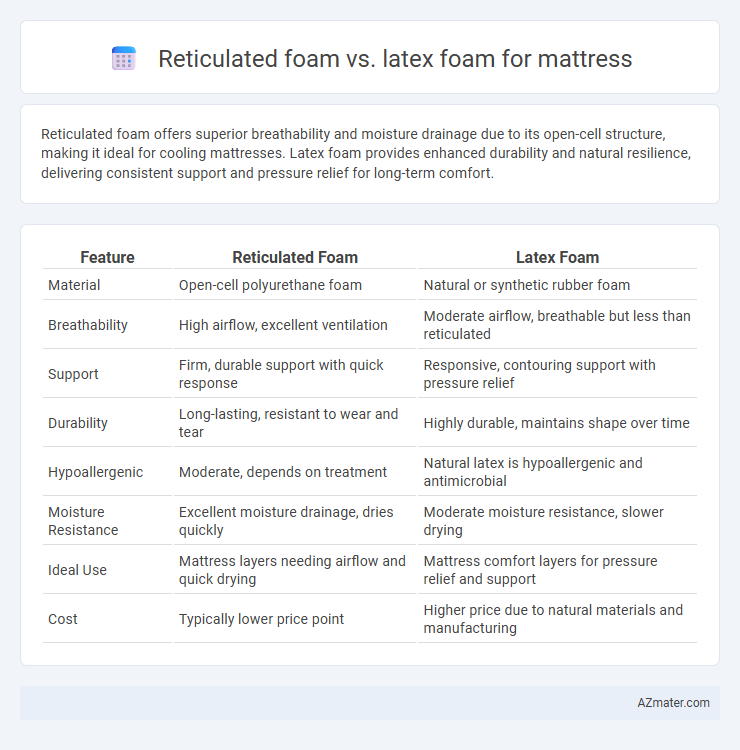Reticulated foam offers superior breathability and moisture drainage due to its open-cell structure, making it ideal for cooling mattresses. Latex foam provides enhanced durability and natural resilience, delivering consistent support and pressure relief for long-term comfort.
Table of Comparison
| Feature | Reticulated Foam | Latex Foam |
|---|---|---|
| Material | Open-cell polyurethane foam | Natural or synthetic rubber foam |
| Breathability | High airflow, excellent ventilation | Moderate airflow, breathable but less than reticulated |
| Support | Firm, durable support with quick response | Responsive, contouring support with pressure relief |
| Durability | Long-lasting, resistant to wear and tear | Highly durable, maintains shape over time |
| Hypoallergenic | Moderate, depends on treatment | Natural latex is hypoallergenic and antimicrobial |
| Moisture Resistance | Excellent moisture drainage, dries quickly | Moderate moisture resistance, slower drying |
| Ideal Use | Mattress layers needing airflow and quick drying | Mattress comfort layers for pressure relief and support |
| Cost | Typically lower price point | Higher price due to natural materials and manufacturing |
Introduction to Reticulated Foam and Latex Foam
Reticulated foam features an open-cell structure created through a specialized process that removes cell membranes, enhancing breathability and durability for mattress applications. Latex foam, derived from natural or synthetic rubber, offers resilient support with excellent pressure relief and hypoallergenic properties. Both foams optimize comfort and airflow, but reticulated foam excels in ventilation while latex provides a balanced combination of elasticity and contouring.
Composition and Structure Differences
Reticulated foam consists of open-cell polyurethane with a highly porous, net-like structure that promotes exceptional airflow and moisture dissipation, making it ideal for breathability in mattresses. Latex foam, derived from natural or synthetic latex, features a dense, buoyant matrix of interconnected cells that offer responsive support and durability while maintaining moderate airflow. The primary structural difference lies in reticulated foam's skeletonized framework that enhances ventilation versus latex foam's uniform cellular structure providing balanced cushioning and resilience.
Breathability and Airflow Comparison
Reticulated foam offers superior breathability and airflow due to its open-cell structure, allowing air to circulate freely and moisture to dissipate quickly compared to latex foam. Latex foam, while naturally hypoallergenic and resilient, has a denser composition that restricts airflow, potentially trapping heat during extended use. Mattresses featuring reticulated foam provide enhanced cooling comfort, making them ideal for individuals prone to overheating at night.
Comfort and Support Levels
Reticulated foam offers high breathability and firm support due to its open-cell structure, making it ideal for pressure relief and airflow in mattresses. Latex foam provides a balanced combination of contouring comfort and resilient support, with natural elasticity that adapts to body movements while maintaining durability. Both materials enhance comfort, but reticulated foam excels in ventilation, whereas latex foam delivers superior responsiveness and long-lasting support.
Durability and Longevity
Reticulated foam features an open-cell structure that enhances breathability but tends to compress and degrade faster than latex foam, impacting its overall durability. Latex foam, derived from natural or synthetic rubber, offers superior resilience and maintains its shape and support for up to 10-15 years, making it more durable in comparison. The inherent elasticity and resistance to sagging in latex foam contribute to a longer lifespan and better long-term comfort for mattresses.
Hypoallergenic and Health Benefits
Reticulated foam offers superior breathability and moisture-wicking properties, reducing the risk of mold and dust mite accumulation, thus enhancing hypoallergenic qualities. Latex foam provides natural resistance to allergens and dust mites due to its antimicrobial properties, promoting healthier sleep environments. Both foams contribute to improved respiratory health by minimizing irritants, but latex foam's eco-friendly composition offers additional benefits for sensitive individuals.
Moisture and Heat Regulation
Reticulated foam features an open-cell structure that promotes superior air circulation, enhancing moisture wicking and heat dissipation for a cooler sleep environment. Latex foam, while naturally breathable due to its resilient, porous composition, tends to retain slightly more heat and moisture compared to reticulated foam. Choosing reticulated foam mattresses can significantly improve temperature regulation and moisture control, making them ideal for hot sleepers or humid conditions.
Environmental Impact and Sustainability
Reticulated foam involves a process that removes cell membranes, improving airflow but relying on petroleum-based materials, which raises concerns about non-renewability and carbon emissions. Latex foam, especially natural latex derived from rubber trees, offers enhanced sustainability due to its biodegradable nature and renewable sourcing, reducing environmental impact. Choosing latex foam contributes to lower lifecycle emissions and supports eco-friendly mattress production compared to the synthetic origins of reticulated foam.
Price and Affordability Overview
Reticulated foam mattresses typically offer a more budget-friendly option compared to latex foam, with prices often ranging from $200 to $800 depending on thickness and density, making them a popular choice for cost-conscious consumers. Latex foam mattresses, known for their durability and natural materials, generally come at a higher price point, starting around $1,000 and going up to $3,000 or more, reflecting their long-lasting quality and hypoallergenic properties. Affordability considerations should weigh upfront cost against lifespan, as latex foam mattresses may provide greater value over time despite their higher initial investment.
Choosing the Right Foam for Your Mattress
Reticulated foam offers high breathability and durability, making it ideal for mattresses requiring enhanced airflow and moisture control. Latex foam provides excellent support and natural resilience with hypoallergenic properties, perfect for sleepers seeking comfort and eco-friendly materials. Choose reticulated foam for superior ventilation and latex foam for contouring support and long-lasting comfort.

Infographic: Reticulated foam vs Latex foam for Mattress
 azmater.com
azmater.com